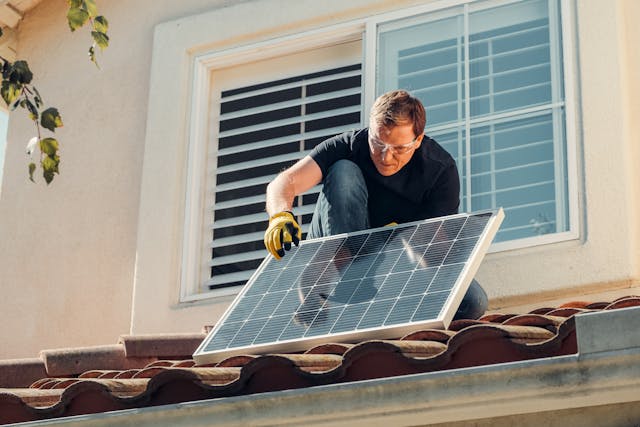Ever dreamt of living in a home that’s not only beautiful but also kind to the planet? Eco-friendly home upgrades are the answer.
Stepping onto this path not only benefits the environment but can also improve your health. Additionally, implementing environmentally friendly upgrades not only reduces your utility expenses but also enhances the value of your residence.
This article will provide you with a detailed plan for turning your home into an eco-friendly sanctuary.
Easy and Affordable Upgrades
Some simple and cost-effective options for enhancing your home’s environmental consciousness include:
Improving Energy Efficiency
Improving the energy efficiency of your home can result in positive environmental impacts and considerable savings. A recommended approach involves substituting conventional incandescent bulbs with LED bulbs, which not only consume less energy but also last longer.
Moreover, the installation of a programmable thermostat allows for automated temperature adjustments according to your routine. This will optimize energy consumption and minimize waste.
According to GlobeNewswire, the surging demand for energy-saving solutions has propelled the growth of the smart thermostat market. These devices are increasingly integrated into smart homes as part of home automation systems.
Projections indicate substantial growth in the smart thermostat market, with estimates suggesting a surge from $4.18 billion in 2023 to $35.70 billion by 2033. This remarkable growth trajectory is expected to be driven by a compound annual growth rate (CAGR) of 23.9%.
Embracing Water Conservation Practices
Water conservation is becoming increasingly crucial, especially in regions facing water scarcity challenges like California.
According to The Mercury News, proposed new regulations could compel dozens of California cities to enact permanent water conservation measures. These regulations would necessitate around 400 of the state’s major cities to establish yearly water usage budgets.
To contribute to water conservation efforts, individuals can take simple yet impactful steps. The installation of low-flow showerheads and faucets leads to a substantial reduction in water usage, while addressing leaky faucets and toilets promptly helps prevent wastage.
Additionally, opting for shorter showers and investing in water-saving appliances like washing machines and dishwashers aids in reducing overall water usage.
Adopting the Practice of Reduce, Reuse, and Recycle
Embracing the principles of reduction, reuse, and recycling forms the guiding principles of sustainable living, conserving resources, and minimizing waste. Implementing a designated recycling and composting system in your home effectively diverts waste from landfills and promotes environmentally friendly practices.
Additionally, reusable items such as shopping bags, water bottles, and coffee mugs reduce reliance on single-use plastics, thereby decreasing waste generation.
Furthermore, donating or selling unwanted items instead of discarding them extends their lifespan and reduces the demand for new products. This practice conserves resources and energy associated with manufacturing.
Mid-Range Investment Upgrades
Moderate investment options for improving the environmental friendliness of your home include:
Installing Solar Panels
The installation of solar panels represents a crucial stride toward attaining energy autonomy and diminishing carbon emissions. By harnessing the sun’s plentiful energy, homeowners can produce clean electricity and diminish their dependence on the conventional grid.
However, before embarking on this eco-friendly investment, it’s essential to consult a roofing contractor who specializes in solar panel installation.
According to Peak Builders & Roofers of San Diego, contractors play a vital role in the design and installation process of solar panels. They assess the property to determine the best location for installation, taking into account factors like structural integrity and roof orientation.
In cases where the existing roof is unsuitable for installation, contractors may suggest a replacement to ensure the panels’ efficiency and longevity.
Partnering with experienced roofing contractors will help ensure maximum energy production and durability. Additionally, reputable contractors offer valuable expertise in navigating permits, regulations, and incentives, streamlining the solar installation process. Click here for more info about roofing contractors.
Buying Energy-Efficient Appliances
When upgrading appliances, prioritize energy efficiency. This will contribute to lower energy bills and play an essential role in reducing greenhouse gas emissions and promoting sustainability.
Significant gains in energy efficiency can be achieved through investments in insulation and low-carbon heating. This is particularly impactful considering that a large portion of homes rely on gas for heating.
Notably, improvements in appliances have led to a 12% reduction in residential electricity consumption in the UK between 2008 and 2018, despite population growth. Embracing appliance efficiency is a straightforward climate solution that benefits both the environment and homeowners’ finances.
Advanced and Long-Term Upgrades
Investing in advanced and long-term upgrades for your home is a proactive approach to enhancing energy efficiency and minimizing environmental impact.
An indispensable aspect of these improvements involves replacing outdated, draft-prone windows and doors with energy-efficient options. These newly installed fixtures boast superior insulation, effectively blocking drafts and preserving a steady indoor temperature. By minimizing heat loss in winter and heat gain in summer, energy-efficient windows and doors help reduce heating and cooling costs.
Another pivotal upgrade involves improving home insulation. Adding insulation to the attic, walls, and crawl space improves the thermal envelope of your home. This prevents heat transfer and enhances overall comfort. Proper insulation also reduces the workload on heating and cooling systems, leading to significant energy savings over time.
Moreover, exploring renewable energy sources offers a sustainable solution for powering your home. Options such as geothermal cooling and heating systems use the stable temperature of the earth to control indoor climates efficiently.
Similarly, wind turbines harness wind energy to generate electricity. They provide a sustainable and environmentally friendly energy source. While the initial expenses of implementing renewable energy systems might be higher, their long-term benefits make them worthy of careful consideration.
In conclusion, the journey towards an eco-friendly home doesn’t have to be overwhelming. By incorporating even a few of the ideas presented in this guide, you can significantly contribute to a more comfortable and cost-effective living space.
Remember, every effort, big or small, adds up to create a lasting positive impact. Start transforming your residence into a green haven today, and inspire others to join you on this journey towards a more sustainable future.


